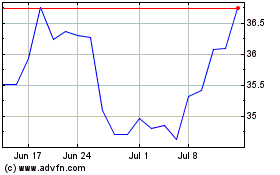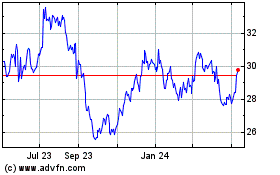AB InBev Aims for $100 Billion In Revenue By 2020
April 01 2016 - 8:50AM
Dow Jones News
Anheuser-Busch InBev NV is well-known for it ambitious goals,
but its latest—$100 billion in revenue by 2020—is a real
stretch.
The goal is part of a new performance-based incentive plan
mentioned in AB InBev's annual report filed March 14. It was first
disclosed in an attachment to a Securities and Exchange filing in
December, shortly after AB InBev announced its roughly $108 billion
deal for rival brewer SABMiller PLC.
As part of the plan, the Belgian company in December issued a
special stock option grant to be awarded to 65 senior managers if
they succeed in boosting the combined companies' revenue more than
50% by 2020. AB InBev's revenue for the 2015 fiscal year was $43.6
billion, while SABMiller's was $22.1 billion, bringing their
combined total to $65.7 billion, excluding divestitures.
If the company achieves the growth targets, the performance plan
could conservatively yield more than $350 million.
An AB InBev spokeswoman said the "2020 Dream Incentive Plan" is
part of an "internal 'stretch target'" and not official company
guidance. She declined to explain why the plan excludes AB InBev's
executive management board—its 16 highest-ranking executives
including Chief Executive Carlos Brito, Chief Financial Officer
Felipe Dutra and six regional presidents. It is unclear what their
performance goals are or if their targets are the same.
What is clear, people who have studied the company say, is to
hit its goal the company will have to either make another big
acquisition or rev up growth considerably.
The brewer has had a better track record of acquiring companies
and cutting costs than growing revenue. After its 2008 acquisition
of Anheuser-Busch, the company delivered sizable profit gains by
cutting staff and increasing prices to counter declining volumes of
beers like Budweiser and Bud Light. A performance incentive plan
after that deal rewarded executives for reducing debt quickly.
But growth has been elusive for AB InBev in the U.S., its
largest market, with volumes and market share declining the past
six years and revenue falling 2% last year after rising just 0.5%
between 2013 and 2014.
In November, Mr. Brito said he planned to expand Bud, Corona and
Stella Artois across new markets in Latin America and Africa, which
account for 68% of SABMiller's revenue. Africa is expected to drive
beer industry growth with compound annual growth of 3.7% through
2020, according industry tracker Plato Logic.
But to reach $100 billion in revenue, AB InBev would have to
increase revenue of the newly-merged company by a rate of about
8.8% annually by 2020 or 6.2% annually by 2022, two additional
years allowed by the plan. That would require a significant
increase from its 2.9% compound annual growth rate since 2009, the
first year after acquiring Anheuser-Busch.
"It is very difficult to see them achieving that [$100 billion
target] without M&A," said Mark Swartzberg, an analyst with
Stifel Nicolaus & Co. He added that the performance plan would
further speculation AB InBev may pursue Coca-Cola Co.
Alternatively, it could look at a spirits company like Diageo PLC
or brewers in Africa or Asia, he said.
Coca-Cola and Diageo declined to comment.
AB InBev's shares were trading at $124.50 on Dec. 22, the day
the options were granted. The options carry an exercise price of
about $123.80, so if shares rise at an annualized rate of about
10%, as the S&P 500 has on average since 1929, then executives
would stand to take home more than $350 million upon the exercise
of their options. If the share price more than doubles by 2020, as
it did over the previous five years, then executives would stand to
earn more than $625 million.
Performance-based incentive plans with rich rewards like that
are common after mergers, said Brian Cadman, a University of Utah
accounting professor who specializes in executive pay. But he said
future performance targets are usually reserved for uncertain
combinations such as the Hewlett-Packard-Compaq and Time Warner-AOL
mergers because the board wants management to ensure the
combination delivers anticipated revenue opportunities.
"The question in all of this is: Is Africa the place?" Mr.
Cadman said. If it doesn't offer the "huge opportunity" they
anticipate, he said AB InBev has incentive to cut another deal
because executives are "set to profit quite substantially if they
meet the target."
Mr. Cadman said it is "puzzling" that AB InBev's 16 top
executives were excluded from the plan. He added, "Generally,
incentives related to growth, and other revenue or earnings targets
are intended to align top executives and midlevel managers, not
separate them."
Write to Tripp Mickle at Tripp.Mickle@wsj.com
(END) Dow Jones Newswires
April 01, 2016 08:35 ET (12:35 GMT)
Copyright (c) 2016 Dow Jones & Company, Inc.
HP (NYSE:HPQ)
Historical Stock Chart
From Mar 2024 to Apr 2024

HP (NYSE:HPQ)
Historical Stock Chart
From Apr 2023 to Apr 2024
